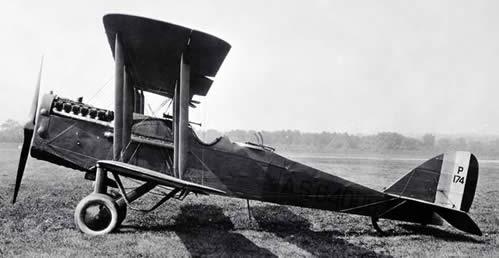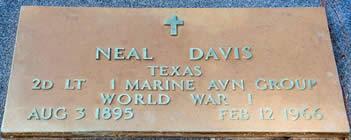 Neal Davis
Neal Davis
World War I – Marine Aviator
1ST Marine Aviation Group – Naval Aviator # 2768
July 14, 2017 - “The only excuse for aviation in any service is its usefulness in assisting the troops on the ground to successfully carry out their operations”………..1st Lt. Alfred A. Cunningham, USMC.
This coming November 10th the United States Marine Corps will celebrate its 242nd birthday. 1On that date the Continental Congress approved the resolution to establish two battalions of Marines able to fight for independence at sea and on shore. “At sea and on shore” but what about in the air? Marine aviation celebrated its 105th year this past May. 2On May 22nd, 1912 USMC First Lieutenant Alfred A. Cunningham reported for flight training at the US Navy’s earliest aviation camp at Annapolis, Maryland and after only two hours and 40 minutes of instruction he soloed and became the Marine Corps first aviator and given the designation “Naval Aviator No. 5”. In his honor, May 22nd has become the official “date of birth” of Marine Corps aviation.
 3When the United States entered the first World War on April 6,1917, Marine aviation consisted of only 6 Marine officers designated naval aviators, 1 warrant officer, and 45 enlisted men. Six months later, the First Marine Aeronautic Company was organized. 4The Marine Corps selected and trained its own flyers and mechanics. Promising enlisted Marines were selected for a 10-week course in groundwork after which they did their actual flying at the Marine flying field, Miami, Florida. Those who completed the program were then commissioned as Second Lieutenants.
3When the United States entered the first World War on April 6,1917, Marine aviation consisted of only 6 Marine officers designated naval aviators, 1 warrant officer, and 45 enlisted men. Six months later, the First Marine Aeronautic Company was organized. 4The Marine Corps selected and trained its own flyers and mechanics. Promising enlisted Marines were selected for a 10-week course in groundwork after which they did their actual flying at the Marine flying field, Miami, Florida. Those who completed the program were then commissioned as Second Lieutenants.
On June 2, 1917 as a 21 year old pre-medical student at the University of Texas Neal Davis of Campti, Texas registered for the World War I draft and two months later on August 7th, 1917 he traveled to Houston, Texas and enlisted in the US Marine Corps four days after his 22nd birthday. He was sent to Parris Island, South Carolina for boot camp after which he became a Marine flying candidate. The requirements were to be of superior physique, weighing from 135 to 165 pounds, with at least two years of college and be between the age of 19 and 39. His training began on October, 12, 1917 and took him to the Aviation Detachment in Philadelphia, Pennsylvania, Mineola, Long Island, and finally to the marine Flying Field, Miami, Florida. Here he studied preliminary, acrobatic and formation flying, bombing, gunnery and reconnaissance including aerial photography. While in training he was promoted to the grade of Corporal on March 2, 1918.

Corporal Davis was discharged on August 22nd, 1918 to accept an appointment as a Second Lieutenant in the USMC Reserve Flying Corps. His character was noted as excellent. The one military document found showed Lt. Davis served overseas in World War I from September, 29, 1918 to November 16th, 1918. Mr. Bill Addison who is a research volunteer at the Naval Aviation Museum in Pensacola, Florida provided the following. “Our information shows that Neal Davis received his wings as a Naval Aviator 28, August 1918. His Naval Aviation number was 2768 which means he was the 2768th person designated a Naval Aviator. He also was probably about the 150th Marine aviator. From your information, he was sent to the Marine Aviation Force at Calais, France arriving October 5, 1918. Just over a month later (November, 11) armistice was declared. In December, the Marines arrived back in the states. There was evidently a rapid draw down and he was discharged in January 1919. The little information we have on combat operations, there is no mention of has name. As you can see by the time line, Neal had little time to make much of a name for himself. But he was an early Marine aviator which places him in a select category. The aircraft used in France was the De Havilland DH-4 and DH-9A.”
6Neal Davis was born August 3rd, 1895 to Zachary Taylor and Sophronia Pittman-Davis in the Campti Community of Shelby County. He came from a large family of seven brothers, Robert Francis, Edward William, Judge Thomas Orange (TO), Zachary Wiley, Judge Thomas Orren, W. I., J. F. and Charles Samuel. He also had five sisters, Elizabeth Davis Holmes (World War I Army Nurse), Ada Hesser, Laura Davis, Cassie Davis and Minnie Downer Holman. After the World War Neal returned to the University of Texas to complete his medical degree and was a prominent physician in the Houston area for many years. He married Miss Marguerite Seagraves on Christmas Day, 1930 in Galveston, Texas and they raised two sons, Odie Richard and Neal II. Having retired and moved back to Center, Dr. Neal Davis passed at Holiday Hospital at the age of 70 on February 12, 1966. He now rests in Oaklawn Memorial Park, Center, Texas with many members of his family.
Sources: (1marines.com/history, 1/2017; 2miramairairshow.com-USMC-aviation history, 1/2017; 3au.af.mil-A Brief History of Marine Corps Aviation; 4United States Marine Corps in World War I, 1968 Reprint of 1920 Edition; 5email, Bill Addison, 1/6/2017; 6Ancestry.com).











